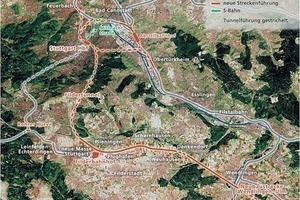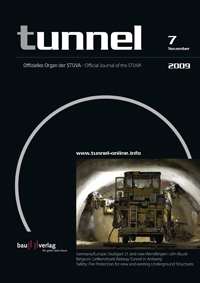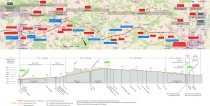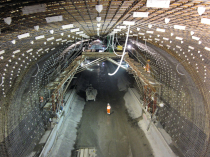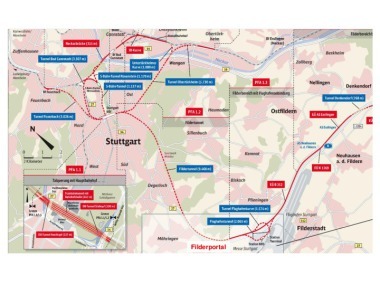Stuttgart 21 and new Wendlingen–Ulm Route
The European high-speed railway network is being continuously expanded. An important element of these plans will be represented by the major project Stuttgart 21 and the new Ulm – Wendlingen route (NBS), which is presented in the following report.
1 Arteries for Europe
The European high-speed railway network (Trans-European Network) is being continuously expanded. The major project Stuttgart 21 – Wendlingen–Ulm is located centrally on the European arteries from Paris via Strasbourg, Stuttgart, Munich, Vienna right up to Bratislava and Budapest (Fig. 1).
The extremely curved inclined route designed to overcome the Swabian Alb with radii of less than 300 m and forcing speed to be diminished to less than 70 km/h, started operating back in 1850 and for some length of time now has not been able to fulfil the requirements posed on an effective high-speed line (Fig. 2). The solution is to be the upgraded and partly new route towards Munich as an extension of the new Mannheim–Stutt-gart route, which has been earmarked in the Federal Transport Infrastructure Plan since 1985 as a matter of urgency. As long ago as 1988 Prof. Heimerl proposed a through station for Stuttgart with the route running close to the motorway in the direction of Ulm. This heralded in the Stuttgart 21 project and the new Wendlingen – Ulm route (NBS) (see box on project history).
1.1 Development of Travelling Times
In addition to the expansion of the mainline arteries for Europe, Stuttgart 21 will provide substantial improvements and cuts in travelling times for local and regional traffic as well. Fig. 3 shows the envisaged cuts in travelling times.
1.2 Project Description Stuttgart 21/new Wendlingen–Ulm Route
The section lengths of Stuttgart 21 and new Wendlingen–Ulm route are in each case around 60 km making them practically identical (Table). In this connection the new Wendlingen–Ulm route (NBS) will be a continuous high-speed route whereas in the case of Stuttgart 21 around the half is planned as a continuous high-speed line. In addition to linking up with the European arteries in Stuttgart the rail hub including the access routes will be completely reorganised. The frequently read assertion that Stuttgart 21 merely constitutes the rebuilding of the station by no means complies with the dimensions of the overall project (Fig. 4).
1.3 Stage reached by Stuttgart 21 Project
Fig. 5 provides an overview of the 7 plan approval sections for Stuttgart 21. For 5 sections a legally binding plan approval decision and in turn the legal right to forge ahead with construction is available. The decisions for plan approval sections 1.3 (Airport/Fairgrounds) and 1.6b (Untertürkheim marshalling yard) are still being awaited.
1.4 Stage reached by new Wendlingen–Ulm Project
Fig. 6 provides an overview of the 7 plan approval sections for the new Wendlingen – Ulm route (NBS). In the plan approval sections 2.1 and 2.3 the linkage with the A 8 motorway can be discerned. A legally binding plan approval decision for the new Wendlingen – Ulm route (PFA 2.1c) exists.
2 Stations
2.1 New Stuttgart Main Station
The new Stuttgart Main Station (Fig. 7) represents the core of the Stuttgart 21 project. The existing terminal station together with the criss-crossing maze of access tracks will be replaced by an underground through station rotated by some 90 degrees. The existing landmarked Bonatzbau will retain its function as the station building together with the station tower (Fig. 8).
There were considerations mooted well over 100 years ago to convert Stuttgart Main Station into a through station. However, these plans were rejected on account of the need for tunnels and the construction technical possibilities available at the time. Instead within the scope of a design competition, won by Paul Bonatz and Friedrich Eugen Scholer, the terminal station was moved from the Bolzstraße to its present location. At the time areas were provided for new city quarters but the divisive effect of the tracks leading towards the north still remains. 100 years later history appears to be repeating itself. Once again a competition was staged for redesigning the station, which was won by the architect Ingenhoven. The supporting structures with “light eyes” will rise from the future Straßburger Platz – thanks to which the underground station is to be provided with natural light (Fig. 9). In the course of time technical possibilities have constantly evolved further and earlier plans can now be accomplished.
After completion of the construction measures all the surface tracks which are no longer required will be removed thus eliminating their divisive effect on the centre of Stuttgart. The areas that become free will be developed in accordance with the urban development plan and a completely new city quarter, the Rosenstein district, will be created. The existing Rosen-stein Square will be enlarged and will then directly link up with the new city quarter.
2.2 Airport Station
But more than Stuttgart’s downtown area will profit from Stuttgart 21. A new traffic hub will be set up on the Fildern Plain directly at Stuttgart Airport and the Neue Messe in close proximity to the motorway. This will interlink planes, trains and cars in an exemplary manner. The existing station terminal is to be connected to the new mainline network and the new NBS station will be established practically next door. In future it will take only 8 min to reach the Airport from Stuttgart Main Station.
2.3 Further Stations
In addition to the stations already mentioned there are to be three more, which are to be upgraded or built afresh. These are the Mittnachtstraße S-Bahn Station, the removal of the Staatsgalerie Underground Sta-tion and the connection at the Ulm Station.
3 Construction Logistics
Altogether some 8 mill. m³ of excavated material and around 1.5 mill. m³ of concrete will be transported to create the tunnel inner shells, stations and engineering structures. According to the current state of planning approx. 4 mill. m³ of excavated material and roughly 0.8 mill. m³ of concrete will be accounted for by the inner urban area around the Main Station. These figures make it evident that Stuttgart 21 will place high demands on construction logistics and transportation. Consider-able amounts of construction materials will have to be supplied while at the same time materials that have been demolished, dug up and removed by tunnelling have to be transported away from the scene. A tailor-made construction logistics concept has been developed in order to assure an optimal and economic construction cycle in the centre of Stuttgart and to reduce dirt and noise emissions as well as nuisance to traffic to a minimum. Towards this end a major part of the construction site logistics will be handled by a construction road independent of local traffic. This road is to run from the Main Station along the existing railway line to the Nordbahnhof. The materials will be temporarily deposited here and can be loaded on to trains and carried away. Furthermore if public roads have to be relocated during construction the number of lanes will not be reduced. Thanks to such measures restrictions to public road traffic will largely be avoided (Figs. 10 and 11).
4 Tunnels
In future many of the tracks will run underground. The bulk of the tunnels will be driven by mining means. On account of the tricky ground conditions in Stuttgart and on the Swabian Alb it is essential to explore the prevailing soil conditions. An extensive drilling and investigation programme was carried out along the entire route. The findings that were thus obtained including anhydrite deposits, squeezing rock, karst cavities and mineral water deposits were considered in the planning process. The NATM was taken as the basis in the plan approval proceedings. The tunnel bores are connected to each other at regular intervals by cross-passages (Fig. 12).
4.1 Stuttgart 21 Tunnels
In Stuttgart around 55 km of tunnels are to be produced either by cut-and-cover or mining means. On the mainline route coming from Mannheim running on to Ulm first of all the Feuerbach Tunnel has to be negotiated. After stopping in the new Main Station the almost 10 km long Filder Tunnel leading to the Airport has to be passed through. Further tunnels to Ober-/Untertürkheim and Bad Cannstatt close the inner urban ring and provide the link with the new marshalling yard at Untertürkheim (Fig. 13).
4.1.1 Filder Tunnel
The Filder Tunnel as well as the tunnels forking off to Ober- and Untertürkheim connects up at the southern end of the new Main Station. Seen from the point of attack the tracks initially run in a south-eastern direction in each case in 2 twin-track mouth-shaped tunnel tubes. Two single-track tubes then join up at a branch structure. The lower part of the Filder Tunnel is planned with a circular profile, the upper part with a mouth-shaped one. There is a cut-and-cover section and the link with the surface section leading to the Airport following the tunnel section driven by mining means. The Filder Tunnel overcomes a difference in elevation of some 160 m. In the inner urban starting-up area the overburden only amounts to some 9 m. Compensation grouting is foreseen in order to protect the existing buildings. Towards the hills the overburden increases rapidly and reached some 220 m in the Degerloch area.
In the lower tunnel section the design speed amounts to 160 km/h and in the upper one 250 km/h. As can be seen from the longitudinal section (Fig. 14) the Filder Tunnel runs through rock layers of unleached swelling gypsum keuper (anhydrite) for several km. Anhydrite means “free of water”. Anhydrite as a water-free sulphate does not absorb water when exposed to moisture for a short period. Given lasting exposure to moisture the anhydrite transforms to gypsum in a chemical process. This process is linked with an increase in volume. High pressures are created given a restricted increase in volume. When determining the gradient for the Filder Tunnel zones were selected, which carry little water, for penetrating the various layers. The two tunnel bores are linked at regular intervals by cross-passages. Two intermediate points of attack are planned. First of all there is the “Haupt-bahnhof Süd” intermediate point of attack, which in its final state will be used as the “Hbf Süd” rescue access. Then there is the intermediate point of attack at the Sigmaringer Straße, which is to be refilled following construction.
4.1.2 Tunnels in Plan Approval Section 1.5
By and large plan approval section 1.5 comprises 4 individual sections: the mainline feed Stuttgart - Feuerbach, the mainline feed Stuttgart–Bad Cann-statt, the Stuttgart North– Stuttgart Hauptbahnhof (un-
derground) and the S-Bahn route Hauptbahnhof-Stuttgart – Bad Cannstatt – Bahnhof Stuttgart – Mittnachtstraße.
The Stuttgart – Feuerbach feed starts in Feuerbach with a trough structure followed by a cut-and-cover tunnel before converting to a tunnel driven by mining means. The following single-track tunnel bores underpass the Killesberg, the old fairgrounds, the urban railway tunnel leading to the Messe and the Kriegsberg residential areas with overburdens between some 40 and 100 m. Roughly halfway along the tunnel a smoke extraction facility is planned at the Prag intermediate point of attack. Shortly prior to entering the Main Station the single-track directional tunnels from and to Feuerbach and Cannstatt are brought together in a branching structure and run as twin-tracks to the northern end of the new Main Station. The driving operations are to be undertaken from the Prag intermediate point of attack and from the northern end of the Main Station. The Rosenstein Tunnel coming from Bad Cannstatt connects directly with the Neckar Bridge. This is to be produced over a distance of some 60 m both for mainline services as well as for the S-Bahn tunnel located next to them by cut-and-cover with a mouth profile. In each case this is followed up by a twin-track tunnel created by mining means for mainline services and the S-Bahn. The mainline feed is led over the S-Bahn feed by means of the Ehmann-straße junction. At the junction the branching structure for the mainline services splits the twin-track mainline tunnel into 2 single-track ones. The tunnel bores are connected with each other by cross-passages at regular intervals. After the junction the S-Bahn tunnel separates to form 2 single-track directional tunnels. The smoke extraction facility for the mainline feed is located at the Heilbronnerstraße. The driving operations for the mainline services are to be driven from the Nordbahnhof and the northern end of the Main Station points of attack. Those for the S-Bahn are to be executed from the Mittnacht-straße and the Ehmannstraße rescue access intermediate points of attack.
The S-Bahn route Stuttgart Nord – Stuttgart-Hauptbahnhof (underground) links up with the existing line at the Nordbahnhof S-Bahnhof stop. After the bridge at Ehmannstraße the S-Bahn runs in a trough downwards towards the Main Station to the Mittnachtstraße branch structure, which is to be produced by cut-and-cover. Here the tracks from and to Stuttgart-Nord are brought together with those from and to Stuttgart-Bad Cannstatt. As the route progresses the new open Mittnacht-straße S-Bahn Station is reached. Between the new Stuttgart-Mittnachtstraße Station and Stuttgart-Hauptbahnhof (under-
ground), the new S-Bahn route is to be produced in the form of a cut-and-cover tunnel. At the Main Station the tunnel links up with the existing system.
4.1.3 Ober-/Untertürkheim Tunnel
The approx. 5.5 km long tunnel runs from Stuttgart Main Station towards Ober-/Unter-türkheim beneath the River Neckar. At that point it forks off towards Ober- and Untertürk-heim and joins up there with the existing system on the surface as well as the railway maintenance station. The maximum overburden amounts to roughly 125 m in the transition zone to the Filder Tunnel. The minimum overburden is roughly 8 m in the zone underpassing the Neckar.
The standard gap between the two tunnel axes amounts to about 30 m. The course of the gradient is governed in particular by the linkage conditions at the plan approval boundaries and the geotechnical marginal conditions. This results in a tub shape for the gradient. The single-track tunnels are connected with one another by means of cross-passages. The tunnel passes through unleached keuper containing gypsum/anhydrite and unleached gypsum keuper as well as quaternary deposits and artificial fills.
4.2 The new Wendlingen– Ulm Route Tunnels
The topographical conditions here also result in much of the route running underground. Coming from Stuttgart on the way to the Swabian Alb first of all the Albvorland, Boßler and Steinbühl Tunnels have to be passed through. On the Alb high plateau the route runs alongside the A 8 motorway until reach-
ing the Albabstieg Tunnel, which comes to an end directly before Ulm Station (Figs. 15 and 16).
4.2.1 Albvorland Tunnel
The Albvorland Tunnel with 2 single-track tubes possesses a length of around 8.1 km. The 2 tunnel bores are linked with each other at regular intervals by cross-passages. The tunnel is located in lower and middle black Jura rocks, which depending on the depth are unweathered to extremely weathered. The greatest overburden amounts to around 65 m.
4.2.2 Boßler Tunnel
The Boßler Tunnel commences at the north-western plan approval boundary with the Aichelberg portal. The tunnel continues towards the south-east and in the process firstly passes beneath the “Roter Wasen” conservation area and then the Boßler heights. In this area the greatest overburden amounting to about 280 m is encountered. The tunnel bores finish up at the northern slope flank of the Filstal valley between the localities of Mühl-hausen i.T. and Wiesensteig (Buch portal). The tunnel tubes are roughly 8.8 km long. A difference in elevation of around 213 m is overcome in the Boßler Tunnel.
The planning process foresees an intermediate point of attack in the form of a roughly 900 m long access tunnel. This is to be refilled at the end of the construction phase. There are sections where squeezing rock conditions have to be reckoned with given that the overburden height extends up to around 213 m.
4.2.3 Steinbühl Tunnel
The Steinbühl Tunnel starts on the southern side of the Filstal at the Todsburg portal and continues towards the south-east. It subsequently underpasses the Eselhöfe heights with some 90 m of overburden. The tunnel finishes up south-east of Hohenstadt at the Hohenstadt portal. The tunnel is roughly 4.8 km long and a height elevation of around 105 m has to be overcome. It passes through all white Jura formations. Karstification phenomena are to be reckoned with over a large part of the tunnel route.
4.2.4 Albabstieg Tunnel
The Albabstieg Tunnel consists of 2 single-track bores, which are each roughly 5.8 km long. The tubes possess a basket arch cross-section, whose size is geared to the given speed. The 2 tubes are linked by cross-passages commensurate with the evacuation and rescue concept. Light and heavy mass-spring systems are to be installed in parts of the tunnel tubes to counteract vibration.
The rock conditions in the Albabstieg Tunnel zone and the tunnel for the intermediate point of attack are characterised by a structure comprising layers of white Jura and lower sweet water molasse.
5 Bridges
More than 50 bridges are scheduled to be built for the Stuttgart 21 and Wendlingen – Ulm project. In addition to minor road and rail overpasses, the large valley bridge over the Fils and the one crossing the Neckar in Stuttgart are worthy of mention.
5.1 Neckar Bridge in Stuttgart The new route section (mainline and S-Bahn feed to Bad Cannstatt) requires a new railway bridge to be constructed over the Neckar. This bridge is to be built to jointly carry mainline and S-Bahn trains. The bridge is to be some 355 m long and will be roughly 24 m wide. It will cross the Neckar Valley in the form of a continuous beam bridge with 8 fields and will not only span the River Neckar but also the Schönestraße at the Bad Cannstatt side and the Neckartalstraße at the Rosen-steinpark side (B 10).
Over the Neckar at the Bad Cannstatt side the track alignment of S-Bahn and mainline services, which run parallel, facilitates a joint four-track superstructure. At the Rosensteinpark side the routes for the S-Bahn and mainline trains are divided up on account of the 2 separate tunnels that follow so that at that point the bridge splits up to form 2 twin-track superstructures. The existing wooden bridge across the Neckar has to make way for the new bridge. The new path for cyclists and pedestrians across the Neckar is to be suspended beneath the new railway bridge (Fig. 17).
5.2 Filstal Bridge
The bridge spans the River Fils at a height of some 85 m. Two parallel bridges, each roughly 485 m long, are to be built alongside one another. In the west the Filstal Bridge connects with the Boßler Tunnel and in the west with the Steinbühl Tunnel. The supports are V-shaped and the greatest span width amounts to roughly 150 m.
6 Conclusion
In summing up it can be asserted that the Stuttgart 21 – Wendlingen–Ulm project represents the optimal solution for the future-oriented redesigning south-west Germany’s railway infrastructure: as an element of the arteries from Paris via Vienna to Bratislava for long-distance trains as well as for regional and commuter traffic.

